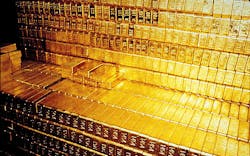Geothermal Technology: There’s Gold in Them Hills
Nobody in the HVAC industry denies the importance of geothermal technology. I’m sure there are many contractors, however, who may not know that it represents one of the biggest growth sectors in the industry. It’s still expensive, but I’m here to tell you “thar’s gold in them hills.”
Recently San Antonio-based research and analysis firm Frost & Sullivan came out with a study that says the geothermal market is expected to reach $147.6 million by 2017. In fact, they claim that geo’s share of market was to the tune of $102 million in 2012. We’re not talking pennies here.
As a reminder — heating and cooling consumes nearly half of the electric power used in non-residential buildings in the U.S. — it’s obvious that there’s a need to better control and reduce that energy use. It’s no surprise that for years we’ve been talking about how geothermal may very well be the answer to that need.
We were right.
The Frost and Sullivan study (bit.ly/geostudy) states that despite the large first costs, geothermal is “capturing the attention of environmentalists and users across the country and around the world.”
This study covers a period of time from 2009 and forecasts through 2017: the base year being 2012. It focuses on open- and closed-loop geothermal heat pumps as the two key segments in the North American geothermal HVAC market and acknowledges that the technology is and will continue to get a boost from legislation. In the U.S., that means the Energy Policy Act and the Energy Independence and Security Act.
This is great news for HVAC contractors who choose to or already are selling geothermal technology to their customers. On the residential side it remains very expensive. However, on the commercial side, it’s certainly more affordable and the payback times more reasonable. Even then, the study finds that in this pseudo recessionary time, end users are still cautious about their expenditures and many building owners/managers are thinking more short-term rather than looking at the long-term energy savings.
There is also plenty of misinformation about the costs and paybacks of geothermal. It might be helpful to debunk some of these myths with your customers.
For example, one common misconception is that geothermal HVAC needs a lot of real estate to install the earth loops.
The truth, according to Jay Egg, a former mechanical systems contractor who focused on geothermal and has written a number of books for National Geographic on the topic, “Depends on the characteristics of the site. The earth loop may be buried vertically, meaning little above-ground surface is needed. Or, if there is an available aquifer that can be tapped into, only a few square feet of real estate are needed. Remember, water is returned to the aquifer after passing over a heat exchanger, so it is not ‘used’ or otherwise negatively impacted.”
Regarding longevity, contractors worry about how long it takes for the systems to wear out and the cost to repair them.
Egg writes, “Earth loops can last for generations. The heat-exchange equipment typically lasts decades, since it is protected indoors. When it does need to be replaced, the expense is much less than putting in an entire new geothermal system, since the loop or well is the most pricey component to install. New technical guidelines eliminate the issue of thermal retention in the ground, so heat can be exchanged with it indefinitely. In the past, some improperly sized systems did overheat or overcool the ground over time, to the point that the system no longer had enough of a temperature gradient to function.”
He addresses eight other myths in his National Geographic blog at bit.ly/JE-GeoMyths. Also, read Doug Dougherty’s story, “Drilling Down into the Geothermal Industry” on our website for more about the technology: bit.ly/GeoDrillDwn.
One hundred forty seven million dollars is a big deal. Are you ready to get your share?

